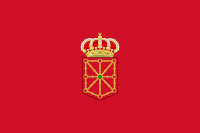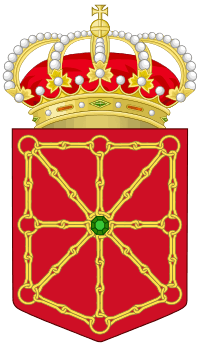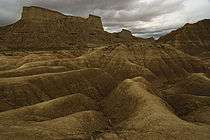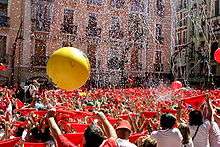Navarre
| Navarre Navarra (Spanish) Nafarroa (Basque) | |||
|---|---|---|---|
| Chartered community | |||
| Comunidad Foral de Navarra (Spanish) Nafarroako Foru Komunitatea (Basque) | |||
| |||
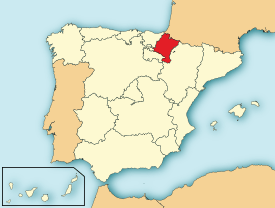 Location of Navarre within Spain | |||
| Coordinates: 42°49′N 1°39′W / 42.817°N 1.650°WCoordinates: 42°49′N 1°39′W / 42.817°N 1.650°W | |||
| Country | Spain | ||
| Capital | Pamplona | ||
| Government | |||
| • President | Uxue Barkos (Geroa Bai) | ||
| Area(2.2% of Spain; Ranked 11th) | |||
| • Total | 10,391 km2 (4,012 sq mi) | ||
| Population (2014) | |||
| • Total | 640,790 | ||
| • Density | 62/km2 (160/sq mi) | ||
| • Pop. rank | 15th | ||
| • Percent | 1.3% of Spain | ||
| Demonym | |||
| ISO 3166-2 | NA | ||
| Official languages | Spanish (Basque is official in the Basque-speaking areas) | ||
| Statute of Autonomy | August 16, 1982 | ||
| Parliament of Navarre | 50 deputies | ||
| Congress seats | 5 (of 350) deputies | ||
| Senate seats | 5 (of 264) senators | ||
| Website | Gobierno de Navarra | ||
Navarre (English /nəˈvɑːr/; Spanish: Navarra; Basque: Nafarroa; French: Navarre), officially the Chartered Community of Navarre (Spanish: Comunidad Foral de Navarra [komuniˈðað foˈɾal de naˈβara]; Basque: Nafarroako Foru Komunitatea [nafaroako foɾu komunitatea]), is an autonomous community in northern Spain, bordering the Basque Country, La Rioja, and Aragon in Spain and Aquitaine in France. The capital city is Pamplona (or Iruña in Basque).
History

Antiquity
During the Roman Empire, the Vascones, a pre-Roman tribe who populated the southern slopes of the Pyrenees, included the area which would ultimately become Navarre. In the mountainous north, the Vascones escaped large-scale Roman settlement, except for coastal areas—Oiasso (Gipuzkoa nowadays). Not so the flatter areas to the south, which were amenable to large-scale Roman farming—vineyards, olives, and wheat crops.
Kingdom of Navarre
Neither the Visigoths nor the Franks ever completely subjugated the area. The Vascones (to become the Basques) included neighbouring tribes as of the 7th century. In AD 778, the Basques defeated a Frankish army at the Battle of Roncevaux Pass. Two generations later, in 824, the Basque chieftain Iñigo Arista was elected King of Pamplona supported by the muwallad Banu Qasi of Tudela, so establishing a Basque kingdom that developed and was later called Navarre.[1] That kingdom reached its zenith during the reign of King Sancho III, comprising most of the Christian realms to the south of the Pyrenees, and even a short overlordship of Gascony (early 11th century).[2]
When Sancho III died in 1035, the Kingdom of Navarre was divided between his sons. It never fully recovered its political power, while its commercial importance increased as traders and pilgrims (the Francs) poured into the kingdom throughout the Way of Saint James.[3] In 1200, Navarre lost the key western Basque districts to Alphonse VIII of Castile, leaving the kingdom landlocked.[4] Navarre then contributed with a small but symbolic force of 200 knights to the decisive Battle of Las Navas de Tolosa in 1212 against the Almohads.
The native line of kings came to an end in 1234; their heirs intermarried with French dynasties.[5] However, the Navarrese kept most of their strong laws and institutions. The death of Queen Blanche I (1441) inaugurated a civil war period between the Beaumont and Agramont confederacies with the intervention of the Castilian-Aragonese House of Trastámara in Navarre's internal affairs.[6] In 1512, Navarre was invaded by Ferdinand the Catholic's troops,[7] with Queen Catherine and King John III withdrawing to the north of the Pyrenees, and establishing a Kingdom of Navarre-Bearn, led by Queen Joan III as of 1555.
To the south of the Pyrenees, Navarre was annexed to the Crown of Castile (1515), but keeping a separate ambiguous status, and a shaky balance up to 1610—King Henry III ready to march over Spanish Navarre. A Chartered Government was established (the Diputación), and the kingdom managed to keep home rule. Tensions with the Spanish Government came to a head as of 1794, when Spanish premier Manuel Godoy attempted to suppress Navarrese and Basque self-government altogether, with the end of the First Carlist War definitely bringing the kingdom and its home rule (fueros) to an end (1839-1841).[8]
Province of Spain


Loss of home rule
After the 1839 Convention of Bergara, a reduced version of home rule (fueros) was passed in 1839. However, the 1841 Act for the Modification of Fueros (later called the "Compromise Act", Ley Paccionada) made definitely the kingdom into a province after a compromise was reached by the Spanish government with officials of the Provincial Council of Navarre. The relocation of customs from the Ebro river to the Pyrenees in 1841 prompted the collapse of Navarre’s customary cross-Pyrenean trade and the rise of smuggling.
Amid instability in Spain, Carlists took over in Navarre and the rest of the Basque provinces. An actual Basque state was established during the Third Carlist War with Estella as its capital (1872-1876), but King Alfonso XII's restoration in the throne of Spain and a counter-attack prompted the Carlist defeat. The end of the Third Carlist War saw a renewed wave of Spanish centralization directly affecting Navarre.
In 1893-1894 the Gamazada popular uprising took place centred in Pamplona against Madrid's governmental decisions breaching the 1841 chartered provisions. Except for a small faction (the so-called Alfonsinos), all parties in Navarre agreed on the need for a new political framework based on home rule within the Laurak Bat, the Basque districts in Spain. Among these, the Carlists stood out, who politically dominated the province, and resented an increased string of rulings and laws passed by Madrid, as well as left leaning influences. Unlike Biscay or Gipuzkoa, Navarre did not develop manufacturing during this period, remaining a basically rural economy.
Republic and military uprising
In 1932, a Basque Country's separate statute failed to take off over disagreements on the centrality of Catholicism, a scene of political radicalization ensued dividing the leftist and rightist forces during the 2nd Spanish Republic (1931-1939). Thousands of landless labourers occupied properties of wealthy landowners in October 1933, leaving the latter eager for revenge.[9] The most reactionary and clerical Carlists came to prominence, ideologues such as Víctor Pradera, and an understanding with General Mola paved the way to the Spanish Nationalist uprising in Pamplona (18 July 1936).
The triumphant military revolt was followed by a terror campaign in the rearguard against blacklisted individuals considered to be progressive ("reds"), mildly republicans, or just inconvenient.[10] The purge especially affected southern Navarre along the Ebro banks, and counted on the active complicity of the clergy, who adopted the fascist salute and even involved in murderous tasks.[11][12] The killing took a death toll of at least 2,857, plus a further 305 dying in prisons (ill-treatment, malnutrition).[13]
The dead were buried in mass graves or discarded into chasms abounding on the central hilly areas (Urbasa, etc.). Basque nationalists were also chased to a lesser extent, e.g. Fortunato Aguirre, a Basque nationalist and mayor of Estella (and co-founder of Osasuna Football Club), was executed in September 1936. Humiliation and silence ensued for the survivors. Pamplona became the rebel launching point against the Republic during the War in the North.
Post-war scene
As a reward for its support in the Spanish Civil War (Navarre sided for the most part with the military uprising), Franco allowed Navarre, as it happened with Álava, to maintain during his dictatorship a number of prerogatives reminiscent of the ancient Navarrese liberties.[14] The bleak post-war years were shaken by shortage, famine, and smuggling, with the economy relying on agriculture (wheat, vineyards, olive, barley), and a negative migration balance. The winners of war came to cluster around two main factions, Carlists and Falangists,[15] while the totalitarian ultra-Catholic environment provided fertile grounds for another religious group, the Opus Dei, to found their University of Navarre (1952), ever more influential in Pamplona.
The coming of the society of consumption and incipient economic liberalization saw also the establishment of factories and workshops during the early 60’s (automobile manufacturing and accessories, etc.), especially around the overgrown capital. It was followed by labour and political unrest. In the run-up to Spanish democracy (Constitution ratified in 1978), Navarre plunged into a climate of violence practised by ETA, police forces, and state-sponsored paramilitary groups, extending during the 1980s, and beyond.
Tension during the Spanish transition
Officials and figures with good connections to the regional government of Navarre went on to join the Adolfo Suarez’s UCD, later splitting into the party UPN led by Jaime Ignacio Del Burgo and Jesús Aizpún Tuero (1979), refusing to join a democratic constitutional process on the grounds that Navarre’s charters (or fueros) remained in place. They also refused to join the Basque process to become an autonomous community, where recently legalized Basque nationalist and leftist parties held a majority.
A continuation of the institutional framework inherited from the dictatorship and its accommodation into the Spanish democracy was guaranteed by the Betterment (“Amejoramiento”), a Navarre-only solution considered ‘an upgrade’ of its former status issued from the (remains of the) charters. In a 3-year span, the Spanish Socialists in Navarre veered in their position, quit the Basque process, and joined the arrangement adopted for Navarre (Chartered Community of Navarre, 1982). The reform was not ratified by referendum, as demanded by Basque nationalist and minority progressive forces.
Politics
Institutions and status
After the end of Franco's dictatorship, Navarre became one of the 17 Autonomous Communities in Spain. The community ceremonies, education, and social services, together with housing, urban development, and environment protection policies are under the responsibility of Navarre's political institutions.
As in the rest of communities, Navarre has a Parliament elected every four years, and the majority in this Parliament determines the president of the Community, who is in charge of Navarre's government.
Unlike most other autonomous communities of Spain (but like the Basque Country), Navarre has almost full responsibility for collecting and administering taxes which must follow the overall guidelines established by the Spanish government but may have some minor differences.
The first 3 presidents of the community belonged to the extinct UCD party. After 1984 the government has been ruled by either the Partido Socialista de Navarra (PSN-PSOE, one of the federative components of the PSOE, main centre-left wing party in Spain) or the UPN (a Navarre-based party that had a long alliance with the PP, main right-wing party in Spain).
Basque nationalist parties also represent a sizeable part of the vote, and even a majority in some northern areas.
Basque nationalist parties have as a key point in their agendas to merge Navarre into the autonomous community of the Basque Country. All Spain-based parties, as well as UPN and PSN, oppose this move.
Present-day political dynamics
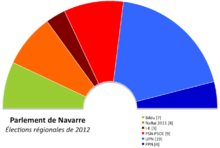
Politics in Navarre has been marked by fierce rivalry between Basque nationalist parties on the one side and the institutional parties, UPN and PSN, on the other. Basque nationalist parties claim that they are excluded from key political posts and institutions, and they point to the intervention of the Madrid government in internal affairs of Navarre. Another complaint involves the ideological profiling of public school Basque language teachers, billed as "ETA supporting teachers". Since the establishment of Navarre's present status (the Amejoramiento, the 'Betterment'), the successive regional governments have been shaken by frequent political instability and corruption scandals. The most stable and longest term in office was held by UPN's Miguel Sanz (2001-2011).
Between 2012 and 2014, a series of corruption scandals broke out involving regional president Yolanda Barcina and other regional government officials that included influence peddling, embezzlement, misappropriation of funds and mismanagement leading to the bankruptcy of Caja Navarra.[16][17] By November 2012, the PSN—UPN's standing ally in Navarre up to that point—backed down on its support of UPN's Barcina, but refused to impeach her or search new political alliances, leaving a deadlocked government.
The regional president, widely questioned in Navarre as of 2012 and relying only on the Conservative central government's backup, went on to urge the Constitutional Tribunal to challenge several decisions made by the Parliament of Navarre.[18] After the latest scandal and corruption allegations affecting a secretary of her cabinet (Lourdes Goicoechea, regional public finance secretary) in February 2014,[19] the Spanish home office secretary Jorge Fernández Díaz stepped in warning leading members of PSN that "Navarre is strategic for Spain", and asserting that any other political alliance means "supporting ETA". The Justice secretary in Madrid Alberto Ruiz Gallardón in turn stated that "the worst political error is not corruption" but getting along with Bildu (a Basque pro-independence coalition).[20]
Geography and climate
Navarre consists of 272 municipalities and has a total population of 601,874 (2006), of whom approximately one-third live in the capital, Pamplona (195,769 pop.), and one-half in the capital's metropolitan area (315,988 pop.). There are no other large municipalities in the region. The next largest are Tudela (32,802), Barañáin (22,401), Burlada (18,388), Estella - Lizarra (13,892), Zizur Mayor (13,197), Tafalla (11,040), Villava/Atarrabia (10,295), and Ansoáin (9,952).
Despite its relatively small size, Navarre features stark contrasts in geography, from the Pyrenees mountain range that dominates the territory to the plains of the Ebro river valley in the south. The highest point in Navarre is Mesa de los Tres Reyes, with an elevation of 2,428 metres (7,965 feet). Other important mountains are Txamantxoia, Kartxela, the Larra-Belagua Massif, Sierra de Alaiz, Untzueko Harria, Sierra de Leyre, Sierra del Perdón, Montejurra, Ezkaba, Monte Ori, Sierra de Codés, Urbasa, Andia, and the Aralar Range. In the north,climate is affected by the Atlantic Ocean leading an Oceanic west coast climate (Köppen: Cfb) At central Navarre the summer precipitations start to lower, leading to a Mediterranean climate (Köppen: Csa and Csb) At the southernmost part of Navarre the climate is cool semiarid (Köppen: Bsk)
Cultural heritage
Navarre is a mixture of its Vasconic tradition, the Trans-Pyrenean influx of people and ideas and Mediterranean influences coming from the Ebro. The Ebro valley is amenable to wheat, vegetables, wine, and even olive trees as in Aragon and La Rioja. It was a part of the Roman Empire, inhabited by the Vascones, later controlled on its southern fringes by the Muslims Banu Qasi, whose authority was taken over by the taifa kingdom of Tudela in the 11th century.
During the Reconquista, Navarre gained little ground at the expense of the Muslims, since its southern boundary had already been established by the time of the Battle of Las Navas de Tolosa in 1212. Starting in the 11th century, the Way of Saint James grew in importance. It brought pilgrims, traders and Christian soldiers from the North. Gascons and Occitanians from beyond the Pyrenees (called Franks) received self-government and other privileges to foster settlement in Navarrese towns, and they brought their crafts, culture and Romance languages.
Jews and Muslims were persecuted both north and south of Navarre, expelled for the most part during the late 15th century to the early 16th century. The kingdom struggled to maintain its separate identity in 14th and 15th centuries, and after King Fernando forcibly annexed Navarre after the death of his wife Queen Isabella, he extended the Castilian expulsion and forcible integration orders applicable to conversos and mudejars of 1492 to the former kingdom. Therefore, Tudela in particular could no longer serve as a refuge after the Inquisitors were allowed.
Energy policy
Navarre leads Europe in its use of renewable energy technology and was planning to reach 100% renewable electricity generation by 2010. By 2004, 61% of the region's electricity was generated by renewable sources consisting of 43.6% from 28 wind farms, 12% from over 100 small-scale water turbines, and 5.3% from 2 biomass and 2 biogas plants. In addition, the region had what was then Spain's largest photovoltaic power plant at Montes de Cierzo de Tudela (1.2 MWp capacity) plus several hundred smaller photovoltaic installations.
Developments since 2004 have included further photovoltaic plants at Larrión (0.25 MWp)[21] and another at Castejón (2.44 MWp), also once the largest in Spain.[22]
Languages

Spanish is the official language throughout Navarre. Basque also has official status in the Basque-speaking area.[23] The northwestern part of the community is largely Basque-speaking, while the southern part is entirely Spanish-speaking. The capital, Pamplona, is in the mixed region. Navarre is legally divided into three linguistic regions: regions where Basque is widespread and official (the Basque-speaking area), regions where Basque is present and has reduced official recognition (the mixed region), and regions where Basque is non-official.[23] In 2006 11.1% of people in Navarre were Basque speakers, 7.6% were passive speakers and 81.3% were Spanish-speaking monolinguals, an increase from 9.5% Basque speakers in 1991.[24] The age distribution of speakers is unequal, with the lowest percentages in the above‑35 age group, rising to 20% amongst the 16-24 age group.[24] The 2011 census showed another small increase in the percentage of Basque speakers to 11.7% (63,000 speakers)[25]
See also
|
- Basque language
- Euskadi
- Caja Navarra
- Kingdom of Navarre
- Kings of Navarre
- Lower Navarre
- Nueva Navarra
- Parliament of Navarre
- Renewable energy in the European Union
Notes and references
- ↑ Collins, Roger (1990). The Basques (2nd ed.). Oxford, UK: Basil Blackwell. ISBN 0631175652., p. 140-141.
- ↑ Collins (1990), p. 181.
- ↑ Collins (1990), pp. 214-215.
- ↑ Collins (1990), pp. 185.
- ↑ Collins (1990), pp. 232.
- ↑ Monreal/Jimeno (2012), pp. 10-15.
- ↑ Monreal, Gregorio; Jimeno, Roldan (2012). Conquista e Incorporación de Navarra a Castilla. Pamplona-Iruña: Pamiela. ISBN 978-84-7681-736-0., pp. 30-32
- ↑ Collins (1990), p. 275.
- ↑ Paul Preston (2013). The Spanish Holocaust: Inquisition and Extermination in Twentieth-Century Spain. London, UK: HarperCollins. p. 182. ISBN 978-0-00-638695-7.
- ↑ Preston, P. 2013, p. 179-181
- ↑ Preston, P. 2013, p. 182-184
- ↑ Charla con Lucio Urtubia [Talks with Lucio Urtubia] (in Spanish). CGT/LKN Bizkaia. 2014-04-15. Event occurs at 07’02. Retrieved 2015-05-01.
(First-hand witness Lucio Urtubia's testimony in Spanish) For the first time ever that is being talked about now, I only bore witness to crimes and abuses in my land carried out by that Church that if it really wanted, all could have been prevented. In the Ribera of Navarre, there are about 4,000 dead by fire-squad, people who had done no harm, no evil to anyone, they were just workers, farmers, the hunger-stricken, so that is why, because they were Republicans, or just affiliated to the CNT or UGT that they were executed by firearm. That was with the complicity of the Catholic Church, that is why I don't believe in that Church, that Church was horrific. That Church had the likes of don Pablo or don Vitoriano, who came down every morning, there were little kids who had just come from shooting in executions, with the former asking to them, "How many, how many today?", the kids going, "Three or four", in turn responding, "Small number, small number". I lived through all that.
- ↑ Preston, P. 2013, p. 183
- ↑ "Navarra. Historia: Franquismo". Auñamendi Eusko Entziklopedia. EuskoMedia Fundazioa. Retrieved 16 September 2014.
- ↑ "Navarra. Historia: Franquismo". Auñamendi Eusko Entziklopedia. EuskoMedia Fundazioa. Retrieved 16 September 2014.
- ↑ "La Cámara de Comptos constata que el Gobierno hizo dejación de funciones al no controlar Caja Navarra". Noticias de Navarra. 13 February 2014. Retrieved 14 February 2014.
- ↑ "Barcina y Sanz duplicaban la reuniones de Caja Navarra para cobrar más en dietas". La Vanguardia. 7 March 2013. Retrieved 14 February 2014.
- ↑ "Barcina arriesga el régimen foral para salvar su Gobierno". Naiz. 11 August 2013. Retrieved 14 February 2014.
- ↑ "La exdirectora de Hacienda acusa a Lourdes Goicoechea de presionar sobre inspecciones a determinados clientes". Noticias de Navarra. 11 February 2014. Retrieved 14 February 2014.
- ↑ "Fernández Díaz: "Navarra es estratégica para España"". Naiz. 13 February 2014. Retrieved 14 February 2014.
- ↑ Iberinco to Construct Solar Installation at Renewable Facility | Renewable Energy Today | Find Articles at BNET
- ↑ Archived September 28, 2006 at the Wayback Machine
- 1 2 IV. Inkesta Soziolinguistikoa Gobierno Vasco, Servicio Central de Publicaciones del Gobierno Vasco 2008, ISBN 978-84-457-2775-1
- ↑ "V Inkesta Soziolinguistikoa" (PDF). Eusko Jaurlaritza. Euskal Autonomia Erkidegoko Administrazioa Hezkuntza, Hizkuntza Politika eta Kultura Saila. 1 July 2013. Retrieved 31 May 2014.
External links
| Wikimedia Commons has media related to Navarre. |
- Official website (in Basque/English/French/Spanish)
- History of Navarre
- (LAS BARDENAS, CAVERN, GROTTE VALTIERRA, CUEVAS DE VALTIERRA)
- Bardenas Reales desert (Navarra)
- Northern Spanish region leads way on renewable energy
- Navarra: Electricity from renewable energy sources PDF (211 KB)
- Euskara Kultur Elkargoa-Basque Cultural Foundation
- Guide to the Navarra Pyrenees mountains.
| ||||||||||||||||
| ||||||||||||
|
